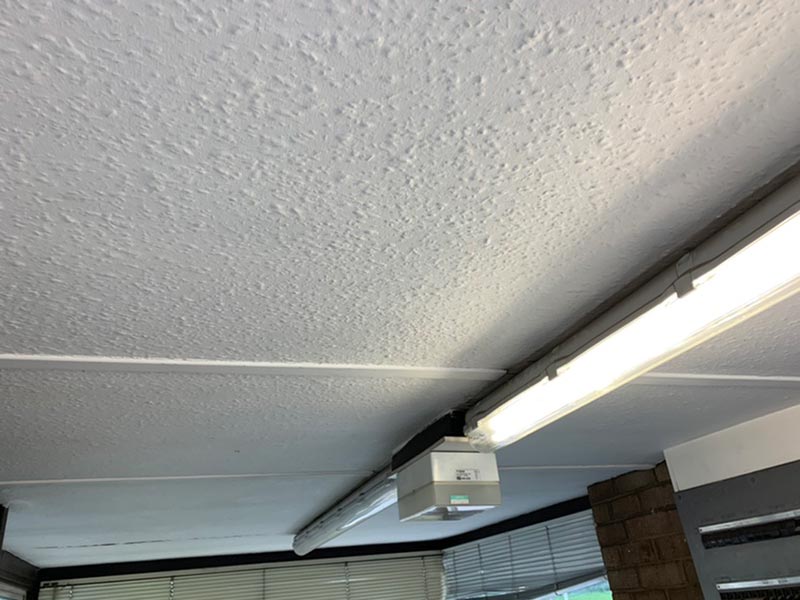Am I insured for asbestos textured coating or Artex?
Asbestos was widely used in residential construction until the material was banned in the late ’90s. One popular use of asbestos was to create textured ceilings and walls to add a decorative look to the home.
While asbestos-containing materials (ACMs) in their complete state aren’t a health risk, toxic, disease-causing fibres can be released if an ACM is disturbed.
Homeowners have a responsibility to keep everyone in their household safe from asbestos exposure. Unfortunately, asbestos exposure can occur due to planned renovations or unplanned natural events, leaving those who live in the home unprotected.
By understanding how your home insurance coverage handles asbestos-related issues, including the removal of textured coatings and Artex, you’ll protect your family and gain peace of mind.
What is asbestos textured coating?
Asbestos textured coating refers to decorative coatings for ceilings and walls. Textured asbestos coating is also referred to as Artex, which is a trademarked brand name. Since other manufacturers produce asbestos textured coating, not all coatings are technically Artex. Today, though, the terms are used somewhat interchangeably.
Textured coating was commonly used for decoration. When applied to a surface like a ceiling or wall, it adds an attractive pattern like fans or swirls.
Is asbestos textured coating dangerous?
In its complete, undamaged state, the asbestos fibres in textured coatings are contained and don’t pose a risk. However, fibres can be released when asbestos coating is disturbed, like when it’s sanded or scraped during renovations.
Also, since asbestos was banned in the UK in 1999, any asbestos textured coating found today will be at least 25 years old. Normal wear and tear can damage asbestos coatings and release fibres without you realising it.
How do I know if my Artex contains asbestos?
Older textured coatings, including Artex, commonly contained white asbestos, called “chrysotile.” Typically, the asbestos content in textured coatings was relatively low at around 1% to 2%. However, some textured coatings have up to 4% asbestos.
It’s widely believed that Artex stopped using asbestos in its products in the mid-1980s. However, other manufacturers continued to use asbestos in textured coatings past that point. Additionally, while asbestos was phased out of new production, it’s possible that older stock continued to be available past that point.
If the material was produced in the UK in 2000 or later, it should not contain any asbestos, as asbestos was banned in 1999. Otherwise, the only way to determine whether or not textured coating contains asbestos is to have a sample taken and analysed by a professional.
Is asbestos textured coating covered by home insurance policies?
The removal of asbestos-containing materials, including Artex and other types of asbestos coatings, are not covered by home insurance on their own.
The stance that most insurers take is that homeowners should know whether or not their home contains asbestos, as well as how to keep ACMs safe to prevent exposure. Since most homeowners have plenty of time to decide how to deal with the ACMs in their homes, many asbestos exposure situations can be prevented.
However, there are certain times when insurance may cover asbestos removal, including remediation for asbestos textured coatings as well as other ACMs.
Under what circumstances might insurance cover the removal of asbestos textured coatings?
If an event that’s covered by home insurance results in damage to otherwise undamaged ACMs, your insurer may cover removal or remediation costs as part of the covered damage.
Home insurance policies often cover the following types of events:
- Explosions
- Falling objects
- Fire and smoke
- Floods
- Leaks
- Lightning strikes
- Theft
- Vandalism
If one of these covered events damages asbestos textured coatings that were previously in an unaltered, safe state, asbestos removal may be included in your home insurance coverage.
It’s important to note that specific events are often not included in your home insurance, such as damage from rodents, earth movements (sinkholes, for example) or normal wear and tear over time.
What should I look for in my insurance policy regarding asbestos coverage?
Fully understanding your insurance coverage is the best way to determine if asbestos removal is covered.
First, you’ll have to determine if your home insurance plan covers the event that caused the asbestos damage. For example, if flooding caused the asbestos coating to peel away, you’ll have to figure out if flooding is covered by your insurer.
Second, you can check your insurance plan to see if there are any specific mentions of asbestos. Even if there is not a section of your coverage that talks about asbestos, that doesn’t mean it won’t be covered.
Third, to clearly understand your home coverage, it’s best to speak with an agent. However, don’t only rely on what the agent says. It’s important to be familiar with your coverage first so you know that the information the agent gives you is accurate.
How do I file an insurance claim for asbestos removal?
To file a claim for asbestos removal, contact your insurance company and speak with an agent. This is the typical process you can expect:
- Gather any support documentation you have.
- Contact your insurer to report the claim.
- Get assigned to a claims adjuster who will handle your case.
- Wait for the adjuster to evaluate your claim and your policy.
- Provide additional support documentation upon request.
- Receive the claim adjuster’s decision.
To provide as much information to the insurance company as possible, it’s important to document everything, from the initial accident to each point of contact and event along the way.
What documentation will I need to provide to my insurance company?
Any and all documentation will be helpful and give you the best chance of receiving compensation for your claim. Document details about the covered event, the damage it caused to the asbestos textured coating, professional inspections and quotes, etc.
You should also take photos of the initial event and any damage it caused. If the condition of the asbestos coating worsens over time, document that as well.
What can I do if my claim for asbestos removal is denied?
If you’re not happy or in agreement with the claim adjuster’s decision, you can appeal it. This means that a person in a higher position at the insurance company will review the claim and your policy to see if a different decision could have been made.
You may be asked to submit additional documentation. Even if you’re not directly asked for more supporting documents, it’s wise to submit them to help your case.
Depending on the severity of your situation, you may want to hire legal help from someone familiar with this type of insurance claim.
What steps should I take if I need to remove asbestos-containing Artex?
Artex and asbestos textured coatings that are not damaged or disturbed — or at risk of being damaged or disturbed — may be best left alone. However, if there’s a chance that the coating could be disturbed and release toxic fibres into the air, you can remove it or plaster over the finish to keep it contained.
If you opt to contain the coating instead of remove it, make sure that you record the details of the work. Since the asbestos is still present, any demolition or renovation crews that may work on the home in the future, along with future homeowners, will need to know about it.
Only trained professionals should work with asbestos-containing materials, regardless of the remediation tactic you decide on. Asbestos experts will know how to protect those in your home from asbestos exposure during the work as well as afterward. They’ll be able to use the appropriate control measures to prevent asbestos from spreading, including properly disposing of it and ensuring your home is safe for occupancy again.
Are there preventative measures I can take to avoid future asbestos claims?
There are several steps you can take to prevent asbestos exposure events and resulting insurance claims in the future, including the following:
- Have an inspector identify the ACMs in your home and suggest remediation options.
- Develop an asbestos management plan, which documents all ACMs on your property, their condition, and actions you plan to take or might need to take to remove them.
- Review your policy thoroughly and any time you change it so that you have a firm grasp on what’s covered, including asbestos damage.
There’s no such thing as a safe asbestos exposure event, and prevention is the best way to avoid asbestos-related incidents.
Final thoughts
Asbestos textured coating, including Artex and materials from other manufacturers, may contain up to 4% asbestos, which poses a particularly dangerous risk if the material is damaged in some way. If you’re unsure about whether or not your home’s coatings include asbestos, have a professional take a sample for analysis.
Should a covered home insurance event cause damage to ACMs, make sure to include detailed information in your claim. It’s possible that your insurer will cover the cost of asbestos removal in some cases.
For more information about asbestos removal, contact Oracle Solutions today.

Written by Jess Scott
Jess Scott has been an all-round asbestos consultant since 1996. That’s nearly 3 decades of asbestos knowledge. He spends his time sharing that knowledge with the team at Oracle and with their clients. Jess's goal is, and always has been, to use my expertise in helping people to comply with the law. This legal compliance ultimately helps to protect everyone from the harmful effects of asbestos. Jess has acted as an asbestos expert witness in legal cases and is involved in many asbestos educational activities throughout the UK.

